A Futuristic Society Envisaged by Big Data
Mosaic City 2050 Concept
Concept: Obayashi Project Team
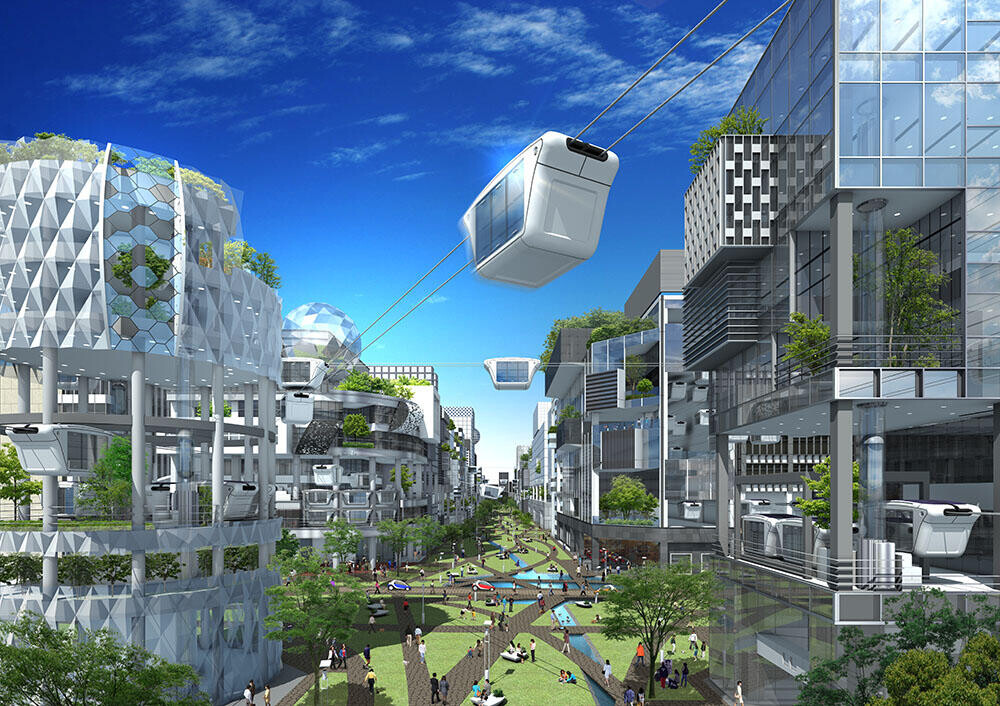
Big data sheds light on unknown parts of society. In the daily lives of individuals and all fields of activity, vast amounts of data reveal previously unnoticed patterns and connections that can serve as guidelines for the next era. What kind of future can we expect from big data? The Obayashi project team envisioned an image of a city while deciphering the potential changes in people and society that big data will bring.
What is Mosaic City? (Basic Concept)
Mosaic City is a futuristic city that is spatially and functionally optimized according to regional characteristics, residents' intentions and needs, and planning challenges by utilizing big data. It can also be called a super compact city, created by using the empty urban space caused by population decline and other factors to create a mosaic of life-related facilities (government offices, offices, schools, hospitals, shops, and others) that individual residents need.
The basic unit of Mosaic City is a personal area (a person's living area) within walking distance of 2 km square. By subdividing the life-related facilities needed by each individual into smaller buildings and facilities, much of daily life can be accomplished within the personal area. The entire city is formed as an aggregate of these individual personal areas.
Compact City and Mosaicization
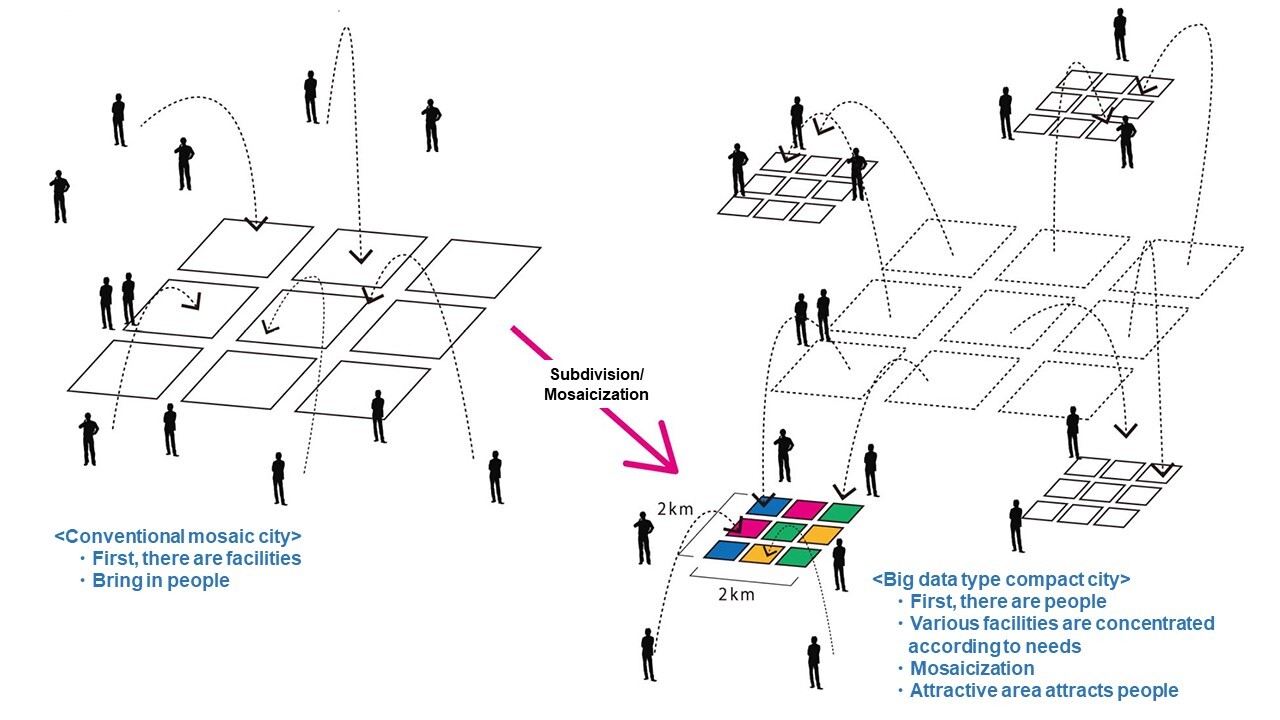
Making Life-Related Facilities Available Anywhere (Urban Functionality)
In terms of urban functionality, the city is characterized by making life-related facilities available anywhere. Instead of traveling to large facilities located far away as is the case in conventional cities, small and highly functional facilities that individuals need will be located close to where they live. As a result, these necessary life-related facilities will be conveniently situated within a short distance from resident's homes.
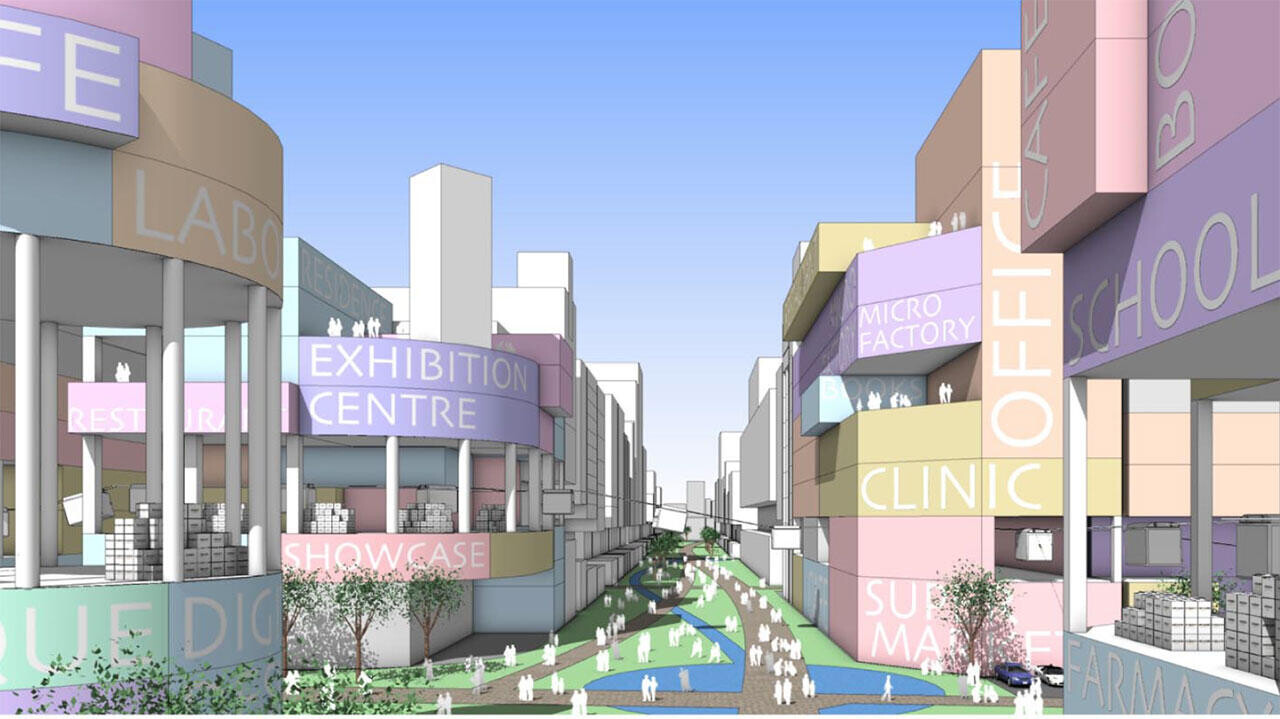
(1) Office anywhere (work environment)
With the development of ICT (Information and Communication Technology), distance and time constraints will be reduced, and large offices will no longer be necessary. Different types of offices will emerge such as home offices and shared offices with like-minded colleagues or people in different fields using empty spaces in buildings, depending on individual business activities, lifestyle patterns, and needs.
(2) My home anywhere (residential environment)
In this concept, current residents will not be relocated, but urban functions such as facilities and infrastructure will be subdivided and relocated. On the other hand, new housing will be built to accommodate individual lifestyles and preferences, expanding the range of choices. As a result, the number of residents in some areas will be higher than before, leading to a revitalization of the city.
(3) Medical care anywhere (medical environment)
Individualized medical care at satellite medical facilities will progress, and routine medical care, except surgical procedures, will no longer require large facilities. Patients can receive precise medical care based on their individual data in small medical facilities in their personal areas. Meanwhile, technological advances that allow patients to communicate with hospitals from their homes will increase home medical care, eliminating the need for hospital visits.
(4) School anywhere (educational environment)
The provision of an individualized education system based on the analysis of data such as students' comprehension skills has already begun. As this system develops, there is a strong possibility that the entire education system, including the unified school attendance system and the grading system, will change as a result of the development of the online system. If you can open a tablet, you can be in school anywhere. Of course, to foster interpersonal communication opportunities for students, small-scale elementary and junior high school facilities are housed within buildings.
(5) Green everywhere (infrastructural environment)
Since Mosaic City is a collection of personal areas within walking distance, most roads other than arterial roads will be empty spaces. If the arterial roads are put underground, the urban axis itself will change drastically. It is assumed that most of the empty roads will be converted into communication spaces such as green areas and parks, and regional centers for urban agriculture (agricultural facilities including rice paddies and fields).
Mosaicization of Space (Architectural Aspect)
Currently, most buildings have a single function (offices, shops, hospitals, residences, etc.), but the central axis of this concept is the reconfiguration of the functions of existing buildings.
In reorganizing the functions of existing buildings, the Obayashi project team focused on environmental aspects, aiming for change without destruction, reconfiguration without destruction, and conversion of buildings into social stock. Specifically, in order to curb CO2 emissions and reduce the burden on the environment, in addition to the above-mentioned conversion of empty space, we have adopted the method of building reduction (i.e., reducing the floor area of the building). This will not only create new space but also improve the local environment in terms of sunlight, ventilation, and airflow.
Changes in Architecture and the City
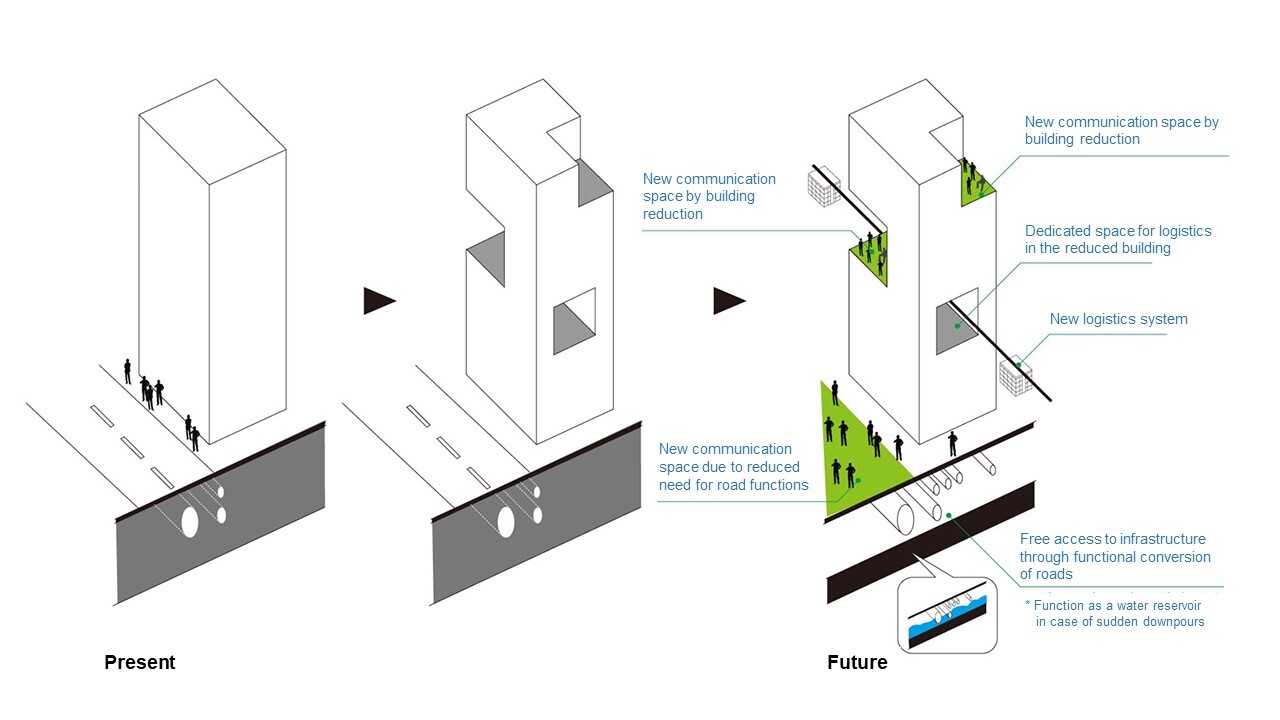
New Logistics Network System
Conventional transportation systems are vehicle-based, but a new approach to logistics is essential in this concept, where people will be walking within their personal areas. The new logistics system will penetrate the personal areas of Mosaic City, connecting individuals to the community and remote areas.
Although there is an idea to move the entire new logistics system underground, an aerial transportation system (ropeway) using carbon nanotube cables will be used to take advantage of the space created by measures such as building reduction.
Concept of Logistics System
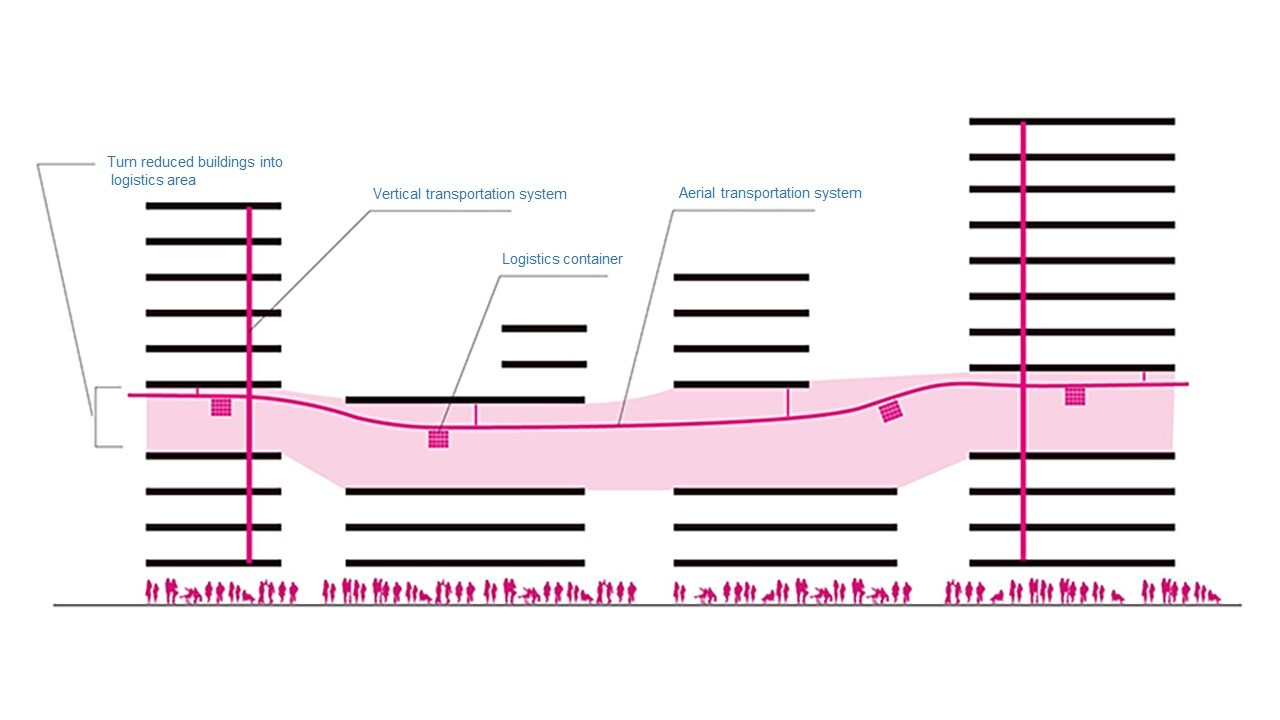
Individuals are also connected to distant production areas via the cable network. Direct connections to local fishing ports and agricultural producers would allow local products to be transported in a matter of hours without going through a market.
City Network
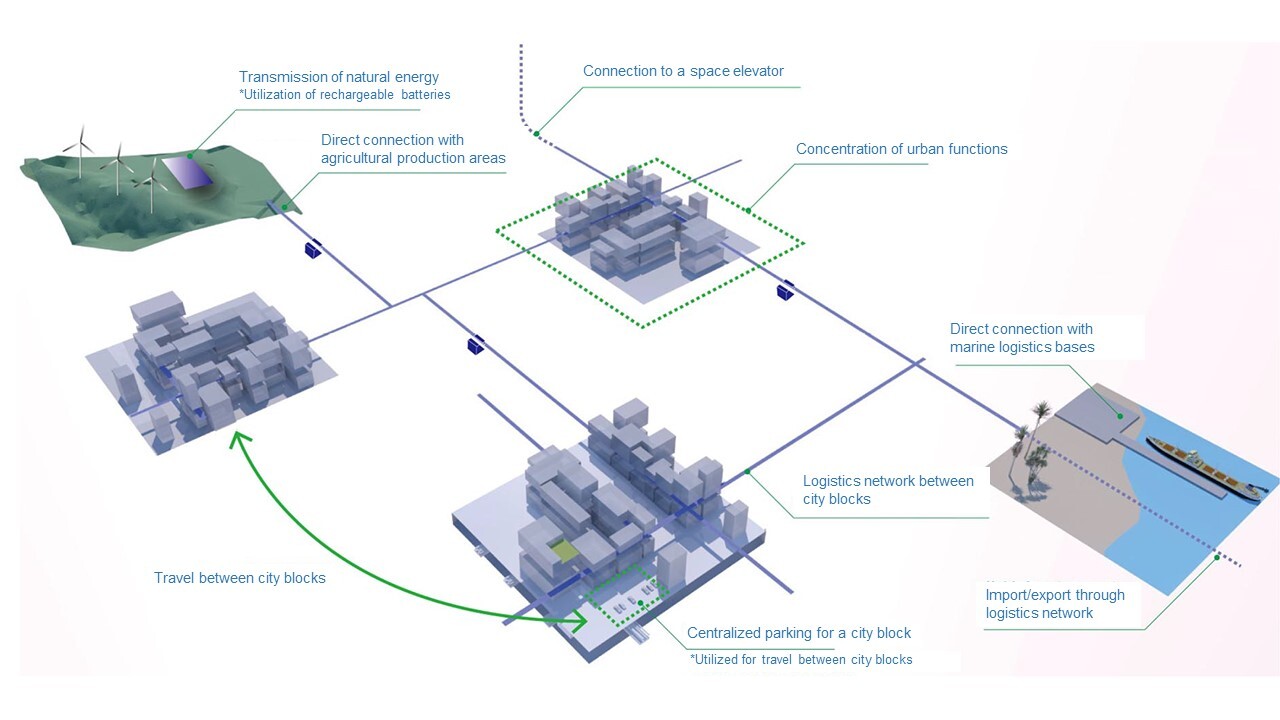
Conclusion
Mosaic City is an image of a new city that explores the possibilities of how future society will be transformed by the use of big data. Although it is difficult to accurately predict the futuristic society, there is a possibility that we will be able to see a future that we have not been able to see before from the vast amount and variety of data that is far greater than what we have seen in the past. We hope that this will not be a surveillance society, as in George Orwell's novel "1984," but one that supports diverse human activities, as in Mosaic City.

